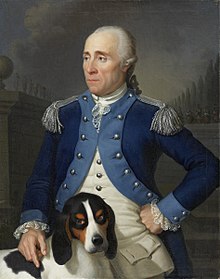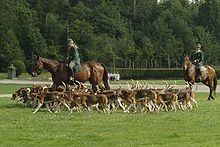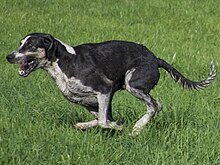Running dog
Hound is the name of a hunting dog that pursues game over long distances. Hounds have a good sense of smell and can follow a track . They were used, among other things, in parforce hunts and drag hunts , which is why the term parforce dog was also used synonymously. Hounds are usually used as a pack : as a group of dogs that hunt together. In Georg Ludwig Hartig's textbook for hunters and those who want to become one (1812) it says:
"Parforce dogs are used to chase a deer, a sow or any other piece of game in numerous companies called packs until it is so exhausted that you can shoot it to death in front of the dogs or catch it."
As early as the 9th century, hunting dog breeds were differentiated for different uses. Among them were medium meutejagende running dogs of the big hounds were distinguished.
Bracken are very similar to the hounds and are often counted among them.
Systematics
The term running dog is still used in the systematics of dog breeds today. The Fédération Cynologique Internationale lists him in their classification of hounds in group 6 , section 1, whereby these breeds are again divided into three subsections according to size.
Section 1.1: Large hounds
- Griffon Nivernais (FCI 17)
- Grand Gascon Saintongeois (FCI 21)
- Grand Bleu de Gascogne (FCI 22)
- Poitevin (FCI 24)
- Billy (FCI 25)
- Bloodhound (FCI 84)
- English Foxhound (FCI 159)
- French hounds (FCI 219, 220 and 316)
- Grand Griffon Vendéen (FCI 282)
- Otterhound (FCI 294)
- Black and Tan Coonhound (FCI 300)
- American Foxhound (FCI 303)
- Grand Anglo-Français (FCI 322-324)
- Chambray (formerly FCI 26, deleted)
Section 1.2: Medium-sized hounds

- Briquet Griffon Vendéen (FCI 19)
- Ariégeois (FCI 20)
- Chien d'Artois (FCI 28)
- Porcelaine (FCI 30)
- Petit Bleu de Gascogne (FCI 31)
- Griffon bleu de Gascogne (FCI 32)
- Finnish Hound (FCI 51)
- Polish Hound (FCI 52)
- Swiss hound (FCI 59)
- Styrian wire-haired hound (FCI 62)
- Brandlbracke (FCI 63)
- Griffon Fauve de Bretagne (FCI 66)
- Tyrolean Bracke (FCI 68)
- Smålandsstövare (FCI 129)
- Schillerstövare (FCI 131)
- Hamiltonstövare (FCI 132)
- Serbian Hound (FCI 150)
- Short-haired Istrian hound (FCI 151)
- Coarse-haired Istrian Hound (FCI 152)
- Posavski Gonič (FCI 154)
- Graver-haired Bosnian Hound - Barak (FCI 155)
- Segugio Italiano (Wirehaired Pointer) (FCI 198)
- Segugio Italiano (Shorthair) (FCI 337)
- Dunker (FCI 203)
- Sabueso Español (FCI 204)
- Hellinikos Ichnilatis (FCI 214)
- Tricolor Serbian Hound (FCI 229)
- Erdélyi Kopó (FCI 241)
- Slovak wild boar hound (FCI 244)
- Hygiene dog (FCI 266)
- Haldenstøver (FCI 267)
- Montenegrin mountain hound (FCI 279)
- Beagle Harrier (FCI 290)
- Harrier (FCI 295)
- Anglo-Français de petite vénerie (FCI 325)
- Gończy Polski (FCI 354)
- Segugio Maremmano (FCI 361)
- Estonian Hound (FCI 366)
Section 1.3: Small hounds
- Grand Basset Griffon Vendéen (FCI 33)
- Basset artésien normand (FCI 34)
- Basset bleu de Gascogne (FCI 35)
- Basset fauve de Bretagne (FCI 36)
- Swiss low dog (FCI 60)
- Petit Basset Griffon Vendéen (FCI 67)
- Westphalian Dachsbracke (FCI 100)
- Drever (FCI 130)
- Beagle (FCI 161)
- Basset Hound (FCI 163)
- German Bracke (FCI 299)
- Basset d'Artois (formerly FCI 18, deleted)
- Steinbracke (formerly FCI 280, deleted)
Individual evidence
- ^ Carl Adam Heinrich von Bose, Friedrich Gottlob Leonhardi: New general practical dictionary of forest and hunting science together with fishing . tape 2 . Hinrichs, Leipzig 1810, p. 79 ( online ).
- ↑ Georg Ludwig Hartig: Textbook for hunters and who want to be . tape 2 . Cotta, Tübingen 1812, p. 128 ( online ).
- ↑ Erik Zimen: The dog. Descent - Behavior - Man and Dog . 5th edition. Goldmann, Munich 1992, ISBN 3-442-12397-6 , pp. 169 .
literature
- Hans-Joachim Swarovsky: BI-Lexicon dog breeds . 2nd Edition. VEB Bibliographisches Institut, Leipzig 1985.
- Erik Zimen : The dog. Descent - Behavior - Man and Dog . 5th edition. Goldmann, Munich 1992, ISBN 3-442-12397-6 .



